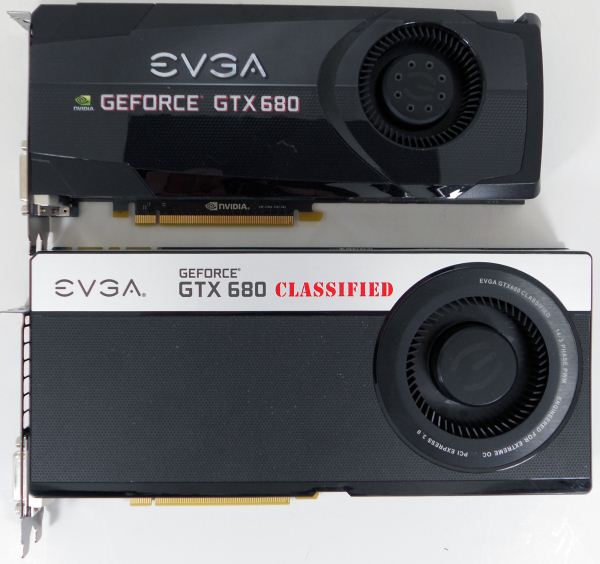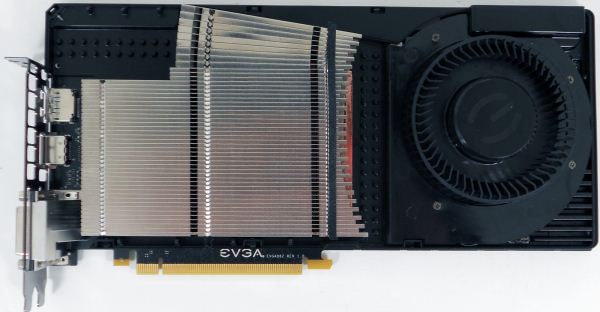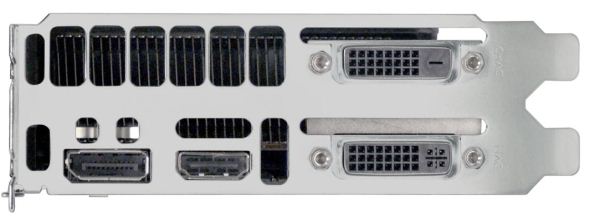EVGA GeForce GTX 680 Classified Review: Pushing GTX 680 To Its Peak
by Ryan Smith on July 20, 2012 12:00 PM ESTMeet The EVGA GeForce GTX 680 Classified
Breaking the card down as we always do, we’ll start with the fundamentals of the card. As we typically see with these premium overclocking cards, the GTX 680 Classified is far bigger than a standard GTX 680. EVGA is still using a double-wide design, however with the need to fit additional VRM circuitry for overclocking the card is longer and taller than a standard GTX 680. Altogether the GTX 680 Classified measures 11 inches long and 4.95 inches tall, making it roughly an inch longer and an inch taller than NVIDIA’s reference design. Consequently this definitely isn’t a card that will fit in every case – its length should fit in most cases, but depending on the case its height may be an issue.
Along with giving EVGA additional space on their board for power circuitry, the larger card also lets them use a larger cooler, which is necessary for the higher power levels the GTX 680 Classified is intended to operate at. EVGA is well known for their use of NVIDIA’s reference designs, but even when they strike out on their own they like to stick with blowers, making the GTX 680 Classified one of the few custom cards you’ll see with such a cooler.
And like the board itself the cooler is equally large, with EVGA affixing a 80mm radial fan to the card. As with axial fans, radial fans can move more air as they increase in size, which means that not only can EVGA push more air than a standard GTX 680, but they can also do so at lower RPMs with less noise. In fact the card’s fan speed is limited to just 55% in order to pass NVIDIA’s noise requirements, which means it doesn’t get the chance to reach the full potential of what this 24W fan can do.
On the other end of the cooling equation we have EVGA’s heatsink, which like the fan takes advantage of the larger card in order to fit a larger heatsink. This heatsink is a larger version of the stacked fin heatsinks we’ve seen NVIDIA use as of late, with a combination of a copper baseplate and a flat copper heatpipe providing transport to the rest of the aluminum heatsink. Truth be told compared to full-card heatsinks we often see on open-air coolers these stacked fin heatsinks are not particularly big, but these designs prove to be quite efficient as we’ll see.
Sitting below the primary heatsink is EVGA’s aluminum baseplate, which primarily serves to reinforce the card and protect the components, with a secondary duty of serving as a basic heatsink for the RAM and VRM circuitry. We’ve seen these baseplates take on heatsink-like features before – such as with the GTX 690 and its grooves/fins – but this is the first baseplate we’ve seen that uses pin fins instead of full fins.
Last but not least of course we have the real star of the show, EVGA’s custom PCB. As we alluded to earlier, the bulk of the additional bulk of the PCB is used to house extra VRM circuitry, leading to the back-half of the PCB being densely populated while the front half of the PCB is effectively empty along the top-inch. EVGA is using a 14+3 phase VRM configuration here, with 14 phases supplying power to the GPU while 3 more phases supply power to the GDDR5 RAM. This is as compared to a 4+2 configuration for the reference GTX 680.
VRM phases have become something of a competition between vendors, and while it’s not immediately clear whether 14 VRM phases are strictly necessary for this card, going above and beyond the reference GTX 680 certainly is. Not only are the additional phases necessary to smoothly supply power to the GPU and RAM when overclocking (and especially overvolting), but even at its stock state EVGA needs the extra phases thanks to the card’s higher default power target. EVGA’s default power target on the GTX 680 Classified is 250W (330W if using +132% power target), versus 170W(225W w/+132%) on the reference GTX 680; this not only provides some headroom for overclocking, but it means the GTX 680 Classified can reach its top boost bin more often as it doesn’t have to clock down to stay within the 170W power envelope.
Supplying this power is a pair of 8pin PCIe power sockets, which means on paper the GTX 680 Classified can safely draw up to 375W. In practice it’s not clear whether GK104 can actually take that, at least with air cooling, so pushing this card much beyond 300W is mostly in the realm of hardcore water and liquid nitrogen overclockers. Still, the GTX 680 Classified is meant to be overclocked and it definitely has the power delivery system necessary to achieve it.
This brings us to EVGA’s additional features on the PCB specifically for overclockers. First and foremost, to the right of the 8pin PCIe power sockets is the EVGA EVBot header. We will get into EVBot in a moment when we discuss voltage control in general, but this header is the key to maximizing the GTX 680 Classified’s potential. Further to the right we find EVGA’s BIOS selection switch, which has 3 states: Normal, OC, and LN2. The latter 2 BIOSes are in fact identical and exist to disable the card’s power target to enable extreme overclocking. In our (admitted conservative) experience disabling the power target is best left to water and LN2 overclockers, as the default BIOS seems to offer enough headroom (and heat generation) to keep the reference cooler busy.
Moving on, further still to the right we have a voltage monitoring header. Unfortunately the pins are not labeled and difficult to access with probes, as EVGA is intending for the header to be used with not-yet-released adapter that will make it easier to attach probes. Without the adapter a combination of EVBot and software monitoring are the best way to monitor the card’s voltage.
With overclocking out of our way, let’s take a look at the rest of the card. The GTX 680 Classified is a 4GB card, which means EVGA is using 16 GDDR5 RAM chips in a 16bit configuration. 8 are on the front, with the other 8 on the rear. These are the same 6GHz Hynix chips we saw on the GTX 680, and this explains why EVGA isn’t shipping with a memory overclock. As near as we can tell neither Samsung nor Hynix are actually shipping 6.5GHz/7GHz GDDR5 in volume, which would mean that EVGA cannot put faster RAM on the card (though they could still overclock).
Finally we have the GTX 680 Classified’s display port configuration. EVGA is using NVIDIA’s reference configuration here, which means 2 DL-DVI ports, 1 DisplayPort, and 1 HDMI port. The HDMI port is admittedly a bit of a head scratcher – we can’t seriously imagine anyone using such a card to drive a TV, but there you go. EVGA has put the EVBot header here on previous Classified cards, and that may have been a better use of that space in this case.
Wrapping up our look at the GTX 680 Classified, let’s talk about marketing, pricing and availability. One of the things we almost immediately asked EVGA about the GTX 680 Classified is what market segment they‘re shooting for, since ultra-premium is a rather broad category. The GTX 680 Classified is very much a halo part for EVGA, and while it will grab the attention of the press and fans with headlines like hitting 2GHz on LN2, EVGA tells us that most buyers will stick to air cooling. So while the card was built for insane overclocks and abuse on water and LN2 cooling, EVGA clearly expects to sell many of these cards to buyers that will never go beyond the card’s shipping configuration.
Moving on to volume and pricing, Classified cards are usually low-volume parts. Despite that the card has regularly been available from EVGA, so all indications that are the volume of cards is high enough for the market segment EVGA is going after. The toughest part to get over will be pricing: the GTX 680 Classified is a premium variant of what was already a premium product (GTX 680), so EVGA is charging a premium price. The GTX 680 Classified will set you back $660, making it the most expensive GTX 680 currently available. Much of this price hike comes down to the RAM – 4GB GTX 680s start at $590 on Newegg – but even then there’s a further premium thanks to the customized hardware and the fact that this is EVGA’s highest factory overclock. Compared to their next-cheapest 4GB GTX 680, the GTX 680 FTW+, the Classified still carries a $40 premium.
Of course, this doesn’t include the cost of the EVBot controller. If you want one of those – and if you’re intending to overvolt you will – you’ll need to shell out an additional $80, which brings the price of an entire GTX 680 Classified kit to $740. If the hardware isn’t a strong argument that the GTX 680 Classified is an ultra-premium product, the pricing will be an even better argument.















75 Comments
View All Comments
Grooveriding - Friday, July 20, 2012 - link
Very disappointing card for that price. $660 for this ?The MSI GTX 680 Lightning can also be overclocked and overvolted, showed higher overclocks, has a better cooler and costs less than this card.
More disappointment from EVGA along with their scaled back warranty and the need to pay them additional money for extended warranty coverage/stepup program.
/thumbs down
RussianSensation - Friday, July 20, 2012 - link
$740 for the EVBot controller + a card with a blower fan, dinky heatsink (compared to MSI Lightning 7970/680 and Sapphire TOXIC 7970) is overpriced imo. It's not like the extra 100mhz or 4GB of VRAM over 2GB 1230-1290mhz GTX680s will make this card more future proof for next generation games.To make it even more laughable, this card isn't even close to the fastest factory preoverclocked GTX680 either:
http://www.newegg.com/Product/Product.aspx?Item=N8...
If I wanted the best single-GPU with bragging rights, I'd rather get the GTX690 at that point. The 690 would be much faster and quieter and actually be good to go for next gen games. This seems like a marketing exercise.
Ryan Smith - Friday, July 20, 2012 - link
The thing is that I really don't consider a blower to be a negative thing here. This card barely passed 50dB under load, and at the same time it's fully exhausting. Open air coolers have their place, but not having to worry about additional case cooling is quite convenient.RussianSensation - Saturday, July 21, 2012 - link
Ya, I agree that this blower is one of the better ones. But even from your review, the blower was struggling to keep this card under 70*C with overvolting. Under regular overclocking, it worked perfectly fine but the card only reached 1211MHz (1301 with GPU Boost). Those clocks are nothing special and plenty of $500-560 GTX580s such as Gigabyte Windforce 3x, Asus Direct CUII, Zotac AMP!, Galaxy KFA2 can reach those clocks. So the question is why is this card $660? 4GB of VRAM is a waste at 1080/1200P and at 2560x1600 with AA, 1.2ghz HD7970 is faster.But if you are going to overvolt, the cooler suddenly becomes a limitation, especially after buying EVBot for $740. Suddenly you aren't too far off from a real special card - GTX690 - that's actually going to be fast enough to play today's and next generation games. Going from 1301mhz to 1377mhz with volt mod is not going to make GTX680 any better for newer games since that's not good enough, especially after you consider that because it gets too hot, the delta is less than 76mhz in actual gaming.
Sabresiberian - Sunday, July 22, 2012 - link
The overvolted card reached 83C in the review - but the max recommended temp for a GTX 680 is 98C. It did that keeping the noise down to 56.3dB.I tell you what I think - the people that have problems with EVGA's choice of cooling here is simply that it's not sexy. The fact that it works well is secondary.
The overclocked Classified is faster than the 7970GE in 4/5 games @ 2560x1600 in this review. It's faster in 5/9 of them.
Spunjji - Monday, July 23, 2012 - link
I don't think you can call 56.3dB "keeping the noise down", though. That's approaching conversational levels of noise - more importantly the fans on blower heat-sinks sound subjectively worse; less like the broadband noise of a desk fan and more like the drone of a hair-dryer.So, it's not all about "style". There are other legitimate concerns at play here.
CeriseCogburn - Sunday, July 29, 2012 - link
" Supplying this power is a pair of 8pin PCIe power sockets, which means on paper the GTX 680 Classified can safely draw up to 375W. In practice it’s not clear whether GK104 can actually take that, at least with air cooling, so pushing this card much beyond 300W is mostly in the realm of hardcore water and liquid nitrogen overclockers. "blag blah blah blah: is overpriced imo. It's not like the extra 100mhz or 4GB of VRAM
blah blah blah blah: To make it even more laughable
blah blah blah blah: Those clocks are nothing special
blah blah blah blah: This seems like a marketing exercise
You seem like a moron.
RussianSensation - Sunday, September 2, 2012 - link
We were discussing this card's value vs. the GTX680 Lightning. It's worse than the Lightning in overclocking, price and noise levels. Compared to the 7970, it's ridiculously overpriced and will get beaten by a 1250mhz 7970. So there are at least 2 better options on the market: GTX680 Lightning and Sapphire Vapor-X 7970 GE. Plus, at these prices, you can now get HD7950 Crossfire or catch a sale on 2 GTX670s for $340 each. Sorry but $660 for the Classified is a rip-off.As of September 2, this overpriced pile of garbage is still $660 on Newegg, and then you need to add $60+ for EVBot = $720:
http://www.newegg.com/Product/Product.aspx?Item=N8...
That's a joke and a half. Almost $300 more than the Vapor-X, $180 more than the GTX680 Lightning, and still more expensive than the fastest single GPU this round: Sapphire TOXIC 7970.
Plus, this Classified pile of overpriced marketing will get owned by $640 MSI TwinFrozr III 7950s in CF or $730 GTX670 SLI.
Seriously, only non-nonsensical fanboish noise comes out of your mouth. Even among NV's choices, this card is terrible.
Sabresiberian - Sunday, July 22, 2012 - link
Nice link to a deactivated product in which 4/9 of the people that bought it had trouble. I wonder why it was deactivated? Speaks to the quality of your entire post. "Dinky heatsink". Did you read any of the article at all?Yeah, I'm going to be spending all my video card money on Galaxy products, for sure. I especially like that their card had one DisplayPort and 3 HDMI ports. I'm sure I'm going to run 3 TVs off it.
ubernator44 - Monday, September 17, 2012 - link
alright so you must realize that:1; you will never see the potential out of this card with only air or normal liquid cooling.
2; because of #1 anyone who isnt into phase change/ln2/ or sub zero cooling thinks this is a waste.
you must realize that this thing has 18 power phases O.o like holy crap. the only real perk this card has is its amazing ability to reach extreme clocks at low voltages given the fact you use subzero cooling. anything else is just not adiquate. so yes, for 90% of people, this thing is a 660 dollar brick, for us extreme overclockers, this is a godsend! just look at kingpin and what he got off this beast. for you gamers out there that only use a max of normal liquid cooling, a 680 FTW+ is probly all you will want to pay for. anything else (like this card) is useless to you. so yes, amazing card, small market target, but they made it anyway, which is rare for a company to do!